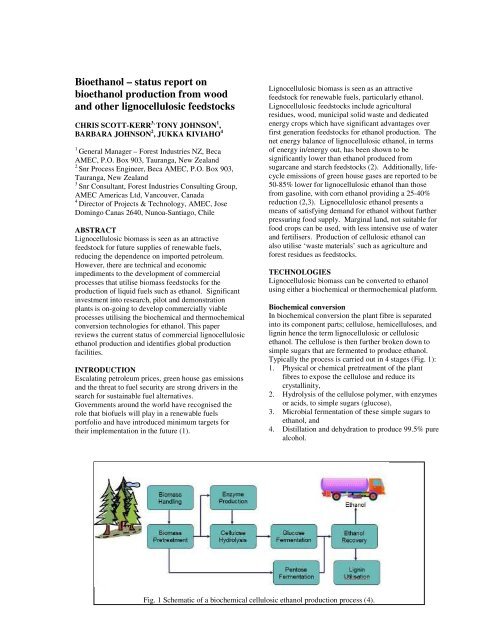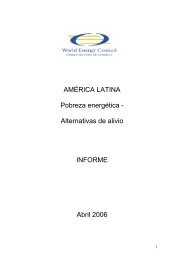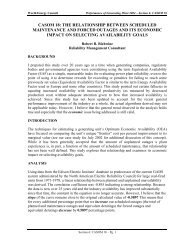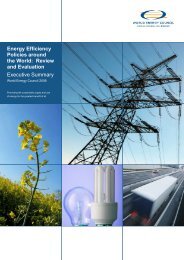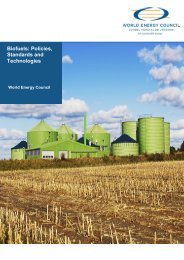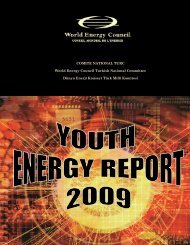Bioethanol – status report on bioethanol production from wood and ...
Bioethanol – status report on bioethanol production from wood and ...
Bioethanol – status report on bioethanol production from wood and ...
Create successful ePaper yourself
Turn your PDF publications into a flip-book with our unique Google optimized e-Paper software.
<str<strong>on</strong>g>Bioethanol</str<strong>on</strong>g> <str<strong>on</strong>g>–</str<strong>on</strong>g> <str<strong>on</strong>g>status</str<strong>on</strong>g> <str<strong>on</strong>g>report</str<strong>on</strong>g> <strong>on</strong><br />
<strong>bioethanol</strong> producti<strong>on</strong> <strong>from</strong> <strong>wood</strong><br />
<strong>and</strong> other lignocellulosic feedstocks<br />
CHRIS SCOTT-KERR 3, TONY JOHNSON 1 ,<br />
BARBARA JOHNSON 2 , JUKKA KIVIAHO 4<br />
1 General Manager <str<strong>on</strong>g>–</str<strong>on</strong>g> Forest Industries NZ, Beca<br />
AMEC, P.O. Box 903, Tauranga, New Zeal<strong>and</strong><br />
2 Snr Process Engineer, Beca AMEC, P.O. Box 903,<br />
Tauranga, New Zeal<strong>and</strong><br />
3 Snr C<strong>on</strong>sultant, Forest Industries C<strong>on</strong>sulting Group,<br />
AMEC Americas Ltd, Vancouver, Canada<br />
4 Director of Projects & Technology, AMEC, Jose<br />
Domingo Canas 2640, Nunoa-Santiago, Chile<br />
ABSTRACT<br />
Lignocellulosic biomass is seen as an attractive<br />
feedstock for future supplies of renewable fuels,<br />
reducing the dependence <strong>on</strong> imported petroleum.<br />
However, there are technical <strong>and</strong> ec<strong>on</strong>omic<br />
impediments to the development of commercial<br />
processes that utilise biomass feedstocks for the<br />
producti<strong>on</strong> of liquid fuels such as ethanol. Significant<br />
investment into research, pilot <strong>and</strong> dem<strong>on</strong>strati<strong>on</strong><br />
plants is <strong>on</strong>-going to develop commercially viable<br />
processes utilising the biochemical <strong>and</strong> thermochemical<br />
c<strong>on</strong>versi<strong>on</strong> technologies for ethanol. This paper<br />
reviews the current <str<strong>on</strong>g>status</str<strong>on</strong>g> of commercial lignocellulosic<br />
ethanol producti<strong>on</strong> <strong>and</strong> identifies global producti<strong>on</strong><br />
facilities.<br />
INTRODUCTION<br />
Escalating petroleum prices, green house gas emissi<strong>on</strong>s<br />
<strong>and</strong> the threat to fuel security are str<strong>on</strong>g drivers in the<br />
search for sustainable fuel alternatives.<br />
Governments around the world have recognised the<br />
role that biofuels will play in a renewable fuels<br />
portfolio <strong>and</strong> have introduced minimum targets for<br />
their implementati<strong>on</strong> in the future (1).<br />
Lignocellulosic biomass is seen as an attractive<br />
feedstock for renewable fuels, particularly ethanol.<br />
Lignocellulosic feedstocks include agricultural<br />
residues, <strong>wood</strong>, municipal solid waste <strong>and</strong> dedicated<br />
energy crops which have significant advantages over<br />
first generati<strong>on</strong> feedstocks for ethanol producti<strong>on</strong>. The<br />
net energy balance of lignocellulosic ethanol, in terms<br />
of energy in/energy out, has been shown to be<br />
significantly lower than ethanol produced <strong>from</strong><br />
sugarcane <strong>and</strong> starch feedstocks (2). Additi<strong>on</strong>ally, lifecycle<br />
emissi<strong>on</strong>s of green house gases are <str<strong>on</strong>g>report</str<strong>on</strong>g>ed to be<br />
50-85% lower for lignocellulosic ethanol than those<br />
<strong>from</strong> gasoline, with corn ethanol providing a 25-40%<br />
reducti<strong>on</strong> (2,3). Lignocellulosic ethanol presents a<br />
means of satisfying dem<strong>and</strong> for ethanol without further<br />
pressuring food supply. Marginal l<strong>and</strong>, not suitable for<br />
food crops can be used, with less intensive use of water<br />
<strong>and</strong> fertilisers. Producti<strong>on</strong> of cellulosic ethanol can<br />
also utilise ‘waste materials’ such as agriculture <strong>and</strong><br />
forest residues as feedstocks.<br />
TECHNOLOGIES<br />
Lignocellulosic biomass can be c<strong>on</strong>verted to ethanol<br />
using either a biochemical or thermochemical platform.<br />
Biochemical c<strong>on</strong>versi<strong>on</strong><br />
In biochemical c<strong>on</strong>versi<strong>on</strong> the plant fibre is separated<br />
into its comp<strong>on</strong>ent parts; cellulose, hemicelluloses, <strong>and</strong><br />
lignin hence the term lignocellulosic or cellulosic<br />
ethanol. The cellulose is then further broken down to<br />
simple sugars that are fermented to produce ethanol.<br />
Typically the process is carried out in 4 stages (Fig. 1):<br />
1. Physical or chemical pretreatment of the plant<br />
fibres to expose the cellulose <strong>and</strong> reduce its<br />
crystallinity,<br />
2. Hydrolysis of the cellulose polymer, with enzymes<br />
or acids, to simple sugars (glucose),<br />
3. Microbial fermentati<strong>on</strong> of these simple sugars to<br />
ethanol, <strong>and</strong><br />
4. Distillati<strong>on</strong> <strong>and</strong> dehydrati<strong>on</strong> to produce 99.5% pure<br />
alcohol.<br />
Fig. 1 Schematic of a biochemical cellulosic ethanol producti<strong>on</strong> process (4).
Lignin is a byproduct of this process, <strong>and</strong> can be used<br />
as a boiler fuel or processed into specialty chemicals.<br />
Hydrolysis <strong>and</strong> fermentati<strong>on</strong> can be c<strong>on</strong>ducted<br />
simultaneously in <strong>on</strong>e stage but simultaneous<br />
saccharificati<strong>on</strong> <strong>and</strong> fermentati<strong>on</strong> (SSF) is yet to be<br />
implemented commercially, significant advances are<br />
being made in this area.<br />
Thermochemical c<strong>on</strong>versi<strong>on</strong><br />
Thermochemical c<strong>on</strong>versi<strong>on</strong> transforms the<br />
lignocellulosic feedstock into carb<strong>on</strong> m<strong>on</strong>oxide <strong>and</strong><br />
hydrogen (syngas) by partial combusti<strong>on</strong> (Fig. 2).<br />
These gases can be c<strong>on</strong>verted to liquid transportati<strong>on</strong><br />
fuels or commodity chemicals by catalytic or biological<br />
pathways. The biological process c<strong>on</strong>verts carb<strong>on</strong><br />
m<strong>on</strong>oxide to ethanol using a n<strong>on</strong>-yeast fermentati<strong>on</strong><br />
microorganism (eg. Clostridium ljungdahlii).<br />
Alternatively, the syngas can be fed to a catalytic<br />
reactor where the carb<strong>on</strong> m<strong>on</strong>oxide <strong>and</strong> water are<br />
combined via a metal-catalysed process to produce<br />
methanol, ethanol, other higher alcohols or liquid fuels<br />
(Fischer-Tropsch liquids). Gasificati<strong>on</strong> is important<br />
because lignin, which c<strong>on</strong>stitutes about 25 <str<strong>on</strong>g>–</str<strong>on</strong>g> 30% of<br />
cellulosic biomass, is also c<strong>on</strong>verted to syngas <strong>and</strong><br />
subsequently c<strong>on</strong>verted to fuel.<br />
CURRENT STATE OF TECHNOLOGIES AND<br />
TECHNICAL CHALLENGES<br />
Biochemical<br />
Pretreatment - the usefulness of cellulose as a<br />
feedstock has been limited by its rigid structure <strong>and</strong><br />
difficulty to breakdown into simple sugars. Costeffective<br />
pretreatments are needed to liberate the<br />
cellulose <strong>from</strong> the lignin/hemicellulose matrix <strong>and</strong><br />
reduce its crystallinity. Pretreatments of increasing<br />
severity are needed as feedstock recalcitrance increases<br />
<strong>from</strong> n<strong>on</strong><strong>wood</strong>s (agricultural residues) to hard<strong>wood</strong>s to<br />
soft<strong>wood</strong>s.<br />
Many pretreatments are currently being explored,<br />
ranging in chemistries <strong>from</strong> very acidic to mildly<br />
alkaline, such as dilute acid, amm<strong>on</strong>ia fibre expansi<strong>on</strong><br />
(AFEX), wet oxidati<strong>on</strong>, solvent based pulping (i.e.<br />
organosolv) <strong>and</strong> steam explosi<strong>on</strong>. The ideal<br />
pretreatment liberates hemicellulose, exposes the<br />
cellulose <strong>and</strong> allows the lignin to be separated <strong>and</strong> must<br />
also minimise the formati<strong>on</strong> of degradati<strong>on</strong> products<br />
that can inhibit the subsequent hydrolysis <strong>and</strong><br />
fermentati<strong>on</strong> processes.<br />
Lignin <str<strong>on</strong>g>–</str<strong>on</strong>g> As lignin is mainly resp<strong>on</strong>sible for<br />
lignocellulosic recalcitrance, particularly in soft<strong>wood</strong>s,<br />
studies have shown its separati<strong>on</strong> during pretreatment<br />
greatly enhances cellulose accessibility <strong>and</strong> enzyme<br />
effectiveness (6). Pretreatments that minimise lignin<br />
redepositi<strong>on</strong> <strong>and</strong> c<strong>on</strong>densati<strong>on</strong> <strong>on</strong> the fibre surfaces are<br />
favoured. Separati<strong>on</strong> of lignin <strong>and</strong> producti<strong>on</strong> of<br />
specialty lignin co-products also has the potential to<br />
improve the overall ec<strong>on</strong>omics.<br />
Hemicellulose <str<strong>on</strong>g>–</str<strong>on</strong>g>Is composed primarily of 5 carb<strong>on</strong><br />
sugars, these may be liberated during the pre-treatment<br />
process or require further treatment with hemi-cellulase<br />
enzymes. The C5 sugars may be fermented to ethanol<br />
or sold as a co-product.<br />
Hydrolysis - Cellulose is broken down into individual<br />
glucose units by cellulase enzymes, under mild<br />
c<strong>on</strong>diti<strong>on</strong>s. Research is <strong>on</strong>-going to find reduce the<br />
costs of enzyme systems that produce high sugar yields<br />
at accelerated rates <strong>and</strong> without the formati<strong>on</strong> of<br />
inhibitory byproducts. Currently, the per unit cost of<br />
enzymes is c<strong>on</strong>sidered to be a deterrent to the<br />
commercial success of the biochemical pathway.<br />
Alternative strategies to reduce enzyme cost include the<br />
recycling of enzymes <strong>and</strong> the use of polymers to reduce<br />
the binding of enzymes to the substrate (7).<br />
Fig. 2 Schematic of a thermochemical cellulosic ethanol producti<strong>on</strong> process (5).
Fermentati<strong>on</strong> - The hydrolysate c<strong>on</strong>tains both 5-carb<strong>on</strong><br />
(pentose) <strong>and</strong> 6-carb<strong>on</strong> (hexose) sugars. The<br />
c<strong>on</strong>versi<strong>on</strong> of pentose sugars into ethanol is less<br />
efficient than c<strong>on</strong>versi<strong>on</strong> of hexose sugars. A system<br />
of mixed-sugar fermenting microorganisms is required<br />
to utilise the full range of sugars present <strong>and</strong> thus<br />
maximise the producti<strong>on</strong> of ethanol. Metabolic<br />
engineering is <strong>on</strong>-going to find low-cost,<br />
microorganisms capable of C5 <strong>and</strong> C6 sugar cofermentati<strong>on</strong><br />
that are also resistant to inhibitors (acetic<br />
acid, furfural) that may be present.<br />
Thermochemical<br />
C<strong>on</strong>taminati<strong>on</strong> <str<strong>on</strong>g>–</str<strong>on</strong>g> various comp<strong>on</strong>ents of the biomass<br />
feedstock can cause problems in the gasificati<strong>on</strong> <strong>and</strong><br />
catalytic synthesis stages. C<strong>on</strong>taminants such as tars<br />
<strong>and</strong> inorganic comp<strong>on</strong>ents (halides, alkalis, ash) present<br />
in the syngas can deactivate the catalysts <strong>and</strong> must be<br />
removed prior to catalytic c<strong>on</strong>versi<strong>on</strong>. The formati<strong>on</strong> of<br />
tars, <strong>and</strong> measures to deal with their removal, are<br />
significant challenges in biomass gasificati<strong>on</strong>.<br />
Advances in gas clean-up <strong>and</strong> catalyst preparati<strong>on</strong>s are<br />
also needed in order to make large-scale biomass to<br />
liquid facilities practical.<br />
ECONOMICS<br />
Both the biochemical <strong>and</strong> thermochemical pathways<br />
require sophisticated processing steps that have higher<br />
operating costs <strong>and</strong> need significant capital investment<br />
compared with grain-based ethanol processes. Based<br />
<strong>on</strong> the current state of technology, capital costs for<br />
biochemical cellulosic ethanol are estimated to be<br />
between US$4.03 <strong>and</strong> $5.60 per US gall<strong>on</strong> of annual<br />
capacity (8, 9). Operating costs are estimated to be<br />
between US$1.34 <strong>and</strong> $1.69 per US gall<strong>on</strong>, depending<br />
up<strong>on</strong> the assumpti<strong>on</strong>s made about feedstock costs,<br />
enzyme costs, <strong>and</strong> the kind of pretreatment to be<br />
employed (8,9). Projected capital costs for future<br />
plants employing anticipated improvements in<br />
biochemical c<strong>on</strong>versi<strong>on</strong> are estimated to be US$3.33-<br />
4.44 per US gall<strong>on</strong> ethanol annual capacity with<br />
operating costs dropping to US$0.40-0.89 per US<br />
gall<strong>on</strong> of ethanol (10). The US Department of Energy<br />
(DOE) has determined that competitiveness with<br />
petroleum can be achieved at an ethanol producti<strong>on</strong><br />
cost of US$1.07/US gall<strong>on</strong> (in 2002 dollars) <strong>and</strong> aims<br />
to achieve this goal by 2012 (5). This compares to the<br />
producti<strong>on</strong> cost of Brazilian sugarcane ethanol of<br />
US$0.81/gal.<br />
Lignocellulosic based ethanol has a further advantage<br />
over starch based ethanol in that the feed stock is not<br />
commodity based <strong>and</strong> subject to brokers <strong>and</strong> trader<br />
speculati<strong>on</strong> <strong>on</strong> pricing. Lignocellulosic based<br />
feedstocks avoid the arbitrage that starch-based ethanol<br />
is subject to; project developers are better able to<br />
forecast <strong>and</strong> manage feedstock costs reducing project<br />
risk. Many starch-based ethanol producers are<br />
currently struggling to survive <strong>and</strong> many may go<br />
bankrupt due to the volatile swings in corn, wheat,<br />
sugar <strong>and</strong> ethanol prices.<br />
A recent study of the producti<strong>on</strong> of Fischer-Tropsch<br />
(FT) liquids <strong>from</strong> syngas has shown the<br />
thermochemical platform to be ec<strong>on</strong>omically<br />
comparable to the biochemical platforms (8).<br />
CELLULOSIC ETHANOL PLANTS<br />
This secti<strong>on</strong> provides brief details <strong>on</strong> all publically<br />
announced <strong>bioethanol</strong> plants based <strong>on</strong> lignocellulosic<br />
feedstocks. The authors have endeavoured to be<br />
comprehensive but do not guarantee all facilities are<br />
included. Table 1 summarises all known facilities as of<br />
February 2009, <strong>and</strong> these are shown geographically <strong>on</strong><br />
Fig. 4.<br />
Table 1 Lignocellulosic Facilities as at February 2009.<br />
Pilot 1 /<br />
Dem<strong>on</strong>strati<strong>on</strong> 2<br />
Commercial 3<br />
Biochemical 25 9<br />
Thermo Chemical 5 3<br />
Note: 1. Pilot Scale is R&D<br />
2. Dem<strong>on</strong>strati<strong>on</strong> Scale is < 10 ML/yr<br />
3. Commercial Scale is > 10 ML/yr<br />
United States<br />
Currently the US has a target of 136,260 milli<strong>on</strong> litres<br />
per year (ML/yr) of renewable fuels producti<strong>on</strong> by<br />
2022. The US Renewable Fuels St<strong>and</strong>ard calls for<br />
60,560 milli<strong>on</strong> liters to come <strong>from</strong> lignocellulosic<br />
sources. The driving force for this requirement is<br />
primarily energy independence; however green house<br />
reducti<strong>on</strong> is a significant motivating factor for the<br />
inclusi<strong>on</strong> of lignocellulosic based fuel.<br />
Dem<strong>on</strong>strati<strong>on</strong>-scale cellulosic ethanol plants are under<br />
c<strong>on</strong>structi<strong>on</strong> as part of the government’s goal to make<br />
cellulosic ethanol cost competitive by 2012. The plants<br />
cover a wide variety of feedstocks, c<strong>on</strong>versi<strong>on</strong><br />
technologies <strong>and</strong> plant c<strong>on</strong>figurati<strong>on</strong>s to help identify<br />
viable technologies <strong>and</strong> processes for full-scale<br />
commercializati<strong>on</strong>. All dem<strong>on</strong>strati<strong>on</strong> plants, which are<br />
sized at 10% of a commercial-scale biorefinery, are<br />
expected to be operati<strong>on</strong>al by 2012. Commercial-scale<br />
plants are in the planning stages. Dem<strong>on</strong>strati<strong>on</strong> <strong>and</strong><br />
commercial plants include:<br />
• Abengoa - Abengoa is using a $76 milli<strong>on</strong> DOE<br />
grant to develop a 42 ML/yr of cellulosic ethanol<br />
integrated biorefinery, in Hugot<strong>on</strong>, Kansas. The<br />
biomass plant will be situated next to a<br />
c<strong>on</strong>venti<strong>on</strong>al cereal-to-ethanol facility to share<br />
feedstocks, including wheat straw <strong>and</strong> corn stover.<br />
Both enzymatic hydrolysis <strong>and</strong> gasificati<strong>on</strong> will be
part of the integrated biorefinery. Ethanol is<br />
produced through enzymatic hydrolysis, while heat<br />
<strong>and</strong> power are generated using gasificati<strong>on</strong>.<br />
Currently the plant processes 70 tpd of biomass.<br />
The plant is being exp<strong>and</strong>ed to h<strong>and</strong>le up to 1500<br />
tpd. Steam explosi<strong>on</strong> pre-treatment will be used<br />
prior to enzymatic hydrolysis. Since mid-2007,<br />
Abengoa has operated a pilot plant in York, NE<br />
using corn stover. 0.08 ML/yr of ethanol can be<br />
produced using enzymatic hydrolysis <strong>and</strong><br />
fermentati<strong>on</strong> of C5 <strong>and</strong> C6 sugars. Abengoa also<br />
has a dem<strong>on</strong>strati<strong>on</strong> scale plant in Spain (Fig. 3)<br />
•<br />
•<br />
•<br />
•<br />
Fig. 3 Abengoa, Castilla, Spain.<br />
• Alico had partnered with New Planet Energy, LLC<br />
to develop <strong>and</strong> commercialise gasificati<strong>on</strong> <strong>and</strong><br />
biological fermentati<strong>on</strong> of ethanol <strong>from</strong> syngas.<br />
Alico has decided to withdraw <strong>from</strong> this project.<br />
New Plant Energy has partnered with INEOS bio<br />
to INP BioEnergy <strong>and</strong> develop a 30 ML/y<br />
gasificati<strong>on</strong> based project in Florida.<br />
• Alltech, through its subsidiary Ecofin, was<br />
planning to develop a dem<strong>on</strong>strati<strong>on</strong> scale facility<br />
in Kentucky. Plans are currently <strong>on</strong> hold.<br />
• Algenol are developing algae strains to c<strong>on</strong>vert<br />
CO2 to ethanol, using photo-bioreactors they clam<br />
to produce up to 6000 USgal/acre of ethanol.<br />
Algenol have partnerships with Dow Chemical,<br />
Linde Group, Valero <strong>and</strong> Biofields. Algenol have<br />
been selected for a $25 milli<strong>on</strong> DOE biorefinery<br />
grant to be built in Freeport, TX.<br />
• American Energy Enterprises (AEE) has proposed<br />
c<strong>on</strong>structi<strong>on</strong> of a cellulosic ethanol facility in New<br />
Milford, C<strong>on</strong>necticut. The plan is build <strong>on</strong>e<br />
producti<strong>on</strong> line with a capacity of 30 to 38 ML/y<br />
<strong>and</strong> then add additi<strong>on</strong>al lines reaching an ultimate<br />
capacity of 300 to 380 ML/y. AEE intends to use<br />
plant biomass <strong>and</strong> <strong>wood</strong> waste as a feed stock for<br />
the ethanol facility.<br />
• Bluefire Ethanol is developing a 15 ML/yr pilot<br />
facility in Lancaster, CA to dem<strong>on</strong>strate<br />
proprietary c<strong>on</strong>centrated acid hydrolysis. This<br />
facility will focus <strong>on</strong> sorted cellulosic waste<br />
diverted <strong>from</strong> l<strong>and</strong>fills. Bluefire are also<br />
developing a 72 ML/yr dem<strong>on</strong>strati<strong>on</strong> project in<br />
Fult<strong>on</strong>, MS. C<strong>on</strong>centrated acid hydrolysis is<br />
<str<strong>on</strong>g>report</str<strong>on</strong>g>ed to have high sugar yields (>90%) <strong>and</strong> can<br />
be easily adapted to a variety of feedstocks. Acid<br />
recovery <strong>and</strong> h<strong>and</strong>ling have been viewed as<br />
barriers to widespread use of this process.<br />
• Coskata has developed gasificati<strong>on</strong> to ethanol<br />
c<strong>on</strong>versi<strong>on</strong> technology that includes syngas<br />
cleaning, a proprietary syngas fermentati<strong>on</strong><br />
organism <strong>and</strong> ethanol recovery using perevaporati<strong>on</strong>.<br />
Coskata claims to be able to produce<br />
cellulosic ethanol for less than the DOE<br />
benchmark price of US$1.07/US gall<strong>on</strong>. The<br />
Coskata process has been developed quietly,<br />
intenti<strong>on</strong>ally keeping a low profile. Coskata<br />
developers have been awarded 16 patents <strong>and</strong><br />
based <strong>on</strong> Arg<strong>on</strong>ne Nati<strong>on</strong>al laboratory analysis is<br />
showing 7.7 times the energy output to energy<br />
input. Coskata has backing <strong>from</strong> GM <strong>and</strong> Khosla<br />
Ventures. They have c<strong>on</strong>structed <strong>and</strong><br />
commissi<strong>on</strong>ed a semi-commercial dem<strong>on</strong>strati<strong>on</strong><br />
facility at the Westinghouse Plasma facility in<br />
Madis<strong>on</strong>, Pennsylvania. Coskata is developing<br />
plans for a 200 to 400 ML/yr commercial scale<br />
ethanol facility.<br />
• Fulcrum-Bioenergy is developing the Sierra<br />
Biofuels Plant to c<strong>on</strong>vert 90,000 t<strong>on</strong>s per year of<br />
municipal solid waste (MSW) to approximately<br />
40 ML/yr of ethanol. Fulcrum is providing<br />
financing, design <strong>and</strong> c<strong>on</strong>structi<strong>on</strong> services for the<br />
facility to be located near Reno, Nevada. The<br />
Sierra Biofuels project uses a plasma enhanced<br />
gasificati<strong>on</strong> to create syngas <strong>from</strong> MSW <strong>and</strong> a<br />
proprietary catalytic technology to c<strong>on</strong>vert the<br />
syngas to ethanol. Start-up is planned for 2012.<br />
• ICM has received DOE funding to c<strong>on</strong>struct a<br />
10 ML/yr cellulosic ethanol dem<strong>on</strong>strati<strong>on</strong> plant to<br />
be co-located at the existing 190 ML/yr corn-based<br />
ethanol plant in St Joseph Missouri. The facility<br />
will process a variety of feed stocks, including<br />
sorghum <strong>and</strong> switchgrass as well as corn stover<br />
residue. The process utilises biochemical<br />
c<strong>on</strong>versi<strong>on</strong> technology - Novozymes are a<br />
collaborator <str<strong>on</strong>g>–</str<strong>on</strong>g> with simultaneous saccharificati<strong>on</strong><br />
<strong>and</strong> fermentati<strong>on</strong>. Significant benefits are to be<br />
achieved via integrati<strong>on</strong> with the corn-ethanol<br />
process <strong>and</strong> utilizati<strong>on</strong> of the vast amounts of<br />
carb<strong>on</strong> dioxide that are given off. ICM intends to<br />
have the plant operati<strong>on</strong>al by Q4 2010.<br />
• KL Energy have developed a process using a mild<br />
pre-treatment, they operate a 1.0 tpd dem<strong>on</strong>strati<strong>on</strong><br />
plant in Upt<strong>on</strong>, Wyoming. KL Energy has 5<br />
commercial project under development, 2 in the<br />
US <strong>and</strong> 3 in Brazil.<br />
• Mascoma has a dem<strong>on</strong>strati<strong>on</strong> plant (0.8-1.9<br />
ML/yr) in Rome, NY, evaluating multiple<br />
feedstocks including hard<strong>wood</strong>. Biochemical<br />
technology, based <strong>on</strong> thermophilic bacteria is used.
A simple pretreatment step precedes a low-cost<br />
cellulose hydrolysis <strong>and</strong> fermentati<strong>on</strong> C<strong>on</strong>solidated<br />
Bioprocessing stage (CBP). The plant has had a<br />
phased start up <strong>from</strong> June 2008. Mascoma is also<br />
Legend: Thermochemical Biochemical<br />
Pilot / Dem<strong>on</strong>strati<strong>on</strong> Pilot / Dem<strong>on</strong>strati<strong>on</strong><br />
Commercial Commercial<br />
• Pacific Ethanol have signed a memor<strong>and</strong>um of<br />
underst<strong>and</strong>ing with Lignol Energy Corporati<strong>on</strong> to<br />
investigate co-locating a Lignol based Biorefinery<br />
at a Pacific Ethanol facility. Lignol was awarded a<br />
DOE grant for the development of a cellulosic<br />
ethanol dem<strong>on</strong>strati<strong>on</strong> plant.<br />
• POET has a pilot-scale cellulosic ethanol facility in<br />
Scotl<strong>and</strong>, South Dakota. This plant is producing<br />
cellulosic ethanol <strong>from</strong> corn cobs at a cost of $0.62<br />
per l ($2.35/USG). POET is developing Project<br />
Liberty which is a $200+milli<strong>on</strong>/95 ML/y<br />
cellulosic ethanol plant in Emmetsburg, Iowa plant<br />
• Raven BioFuels, Pure Energy, Eco-Energy <strong>and</strong><br />
Price BioStock have partnered to develop two<br />
cellulosic ethanol projects, which are each in<br />
various stages of development:<br />
A 79.5 ML/yr plant based <strong>on</strong> <strong>wood</strong> waste is<br />
being developed in Mississippi <strong>and</strong> will<br />
produce furfural in additi<strong>on</strong> to ethanol.<br />
A memor<strong>and</strong>um of underst<strong>and</strong>ing has been<br />
signed with the Kamloops Indian B<strong>and</strong> in<br />
British Columbia. Biomass suitable for<br />
supporting a 26 ML/yr ethanol facility is part<br />
of the MOU. Furfural, Hydroxymethol<br />
Furfural, lignin cake will also be produced as<br />
part of the process. The PureEnergy Process<br />
uses dilute acid hydrolysis with separate C5<br />
<strong>and</strong> C6 fermentati<strong>on</strong>.<br />
Fig. 4 Global <strong>and</strong> Lignocellulosic Ethanol Facilities<br />
planning a 151 ML/yr commercial development in<br />
Kinross, Michigan by 2012 using the CBP<br />
biochemical process.<br />
• Range Fuels - Range Fuels is building the largest<br />
commercial plant in the USA in Sopert<strong>on</strong>, Georgia.<br />
The site, already under c<strong>on</strong>structi<strong>on</strong>, was to<br />
produce 76 ML/yr by the end of 2009, but now<br />
aims for 38 ML/yr by 2010 before ramping up to<br />
378 ML/yr. This plant uses novel gasificati<strong>on</strong><br />
technology producing syngas <strong>and</strong> then mixedalcohol<br />
synthesis with metal catalysts for methanol<br />
producti<strong>on</strong>. Challenges exist with significant<br />
proporti<strong>on</strong>s of tars <strong>from</strong> biomass as feedstock,<br />
compared to fossil fuels.<br />
• Verenium have partnered with British Petroleum<br />
creating a Joint Venture called Vercepia which is<br />
c<strong>on</strong>structing a 136 ML/y in Highl<strong>and</strong>s Florida,<br />
start up is planned for 2012. Verenium is<br />
operating a 5.5 ML/yr dem<strong>on</strong>strati<strong>on</strong> facility in<br />
Jennings, Louisiana. The dem<strong>on</strong>strati<strong>on</strong> plant is<br />
located adjacent to Verenium’s existing integrated<br />
cellulosic ethanol pilot plant that has been<br />
operati<strong>on</strong>al since 1999 <strong>and</strong> capable of processing<br />
about 2 t/d of biomass. The Verenium process<br />
uses dilute acid hydrolysis followed by steam<br />
explosi<strong>on</strong>, liquid/solid separati<strong>on</strong>, followed by<br />
separate C5 <strong>and</strong> C6 sugar fermentati<strong>on</strong>. Proprietary<br />
enzymes are used for the saccharificati<strong>on</strong> of<br />
cellulose.<br />
• ZEAchem have developed a hybrid process results<br />
in very high yields of ethanol. C5 <strong>and</strong> C6 sugars<br />
are fermented to acetic acid using proprietary
organism which give off no CO2. Acetic acid is<br />
c<strong>on</strong>verted esters which are subsequently<br />
hydrogentated to make ethanol. Hydrogen is<br />
obtained through gasificati<strong>on</strong> of the Lignin<br />
removed <strong>from</strong> the biomass.<br />
Canada<br />
The Canadian government has set it sights <strong>on</strong> a target<br />
of 5% renewable fuel in gasoline by 2010 <strong>and</strong> 2%<br />
renewable fuel in diesel by 2012. To support this, the<br />
federal government has established funding of C$550<br />
milli<strong>on</strong> dollars for pilot plants <strong>and</strong> process development<br />
<strong>and</strong> pre-commercial development, with a further C$500<br />
milli<strong>on</strong> for dem<strong>on</strong>strati<strong>on</strong> scale facilities <strong>and</strong> to assist<br />
with bridging the gap between development <strong>and</strong><br />
commercializati<strong>on</strong> of cellulosic ethanol technologies.<br />
Facilities under c<strong>on</strong>structi<strong>on</strong> or planned (11) include:<br />
• Enerkem, Westbury - A 5 ML/yr cellulosic ethanol<br />
commercial dem<strong>on</strong>strati<strong>on</strong> plant has been<br />
comissi<strong>on</strong>ed by Enerkem in Westbury, Quebec.<br />
The plant will use thermal gasificati<strong>on</strong> <strong>and</strong><br />
catalysis technology to produce ethanol <strong>and</strong><br />
methanol <strong>from</strong> treated <strong>wood</strong> waste (end-of-life<br />
cycle power poles). The methanol <strong>and</strong> ethanol<br />
producti<strong>on</strong> modules are to be added early 2009.<br />
The Enerkem themochemical process yield is 360<br />
L/t <strong>wood</strong> waste. Enerkem has partnered with<br />
GreenField Ethanol, a corn ethanol producer, to<br />
commercialise the Enerkem technology. A 36<br />
ML/yr ethanol/methanol plant is planned for<br />
Edm<strong>on</strong>t<strong>on</strong>, Alberta, utilising sorted municipal solid<br />
waste, start up is scheduled for 2011<br />
• Iogen, Ottawa - Since 2004, Iogen has operated a<br />
dem<strong>on</strong>strati<strong>on</strong>-scale plant in Ottawa producing 2.5<br />
ML/yr of ethanol <strong>from</strong> 30 t/d agricultural residues,<br />
including wheat, oat <strong>and</strong> barley straw. The<br />
technology can also be used successfully with<br />
hard<strong>wood</strong>s, but not soft<strong>wood</strong>s. A modified steam<br />
explosi<strong>on</strong> pretreatment is used to liberate the<br />
cellulose, followed by enzymatic hydrolysis <strong>and</strong><br />
fermentati<strong>on</strong> of both C5 <strong>and</strong> C6 sugars. Ethanol<br />
yields of 340 L/t of fibre, are <str<strong>on</strong>g>report</str<strong>on</strong>g>ed. Lignin is<br />
separated <strong>and</strong> used to generate process steam <strong>and</strong><br />
electricity. Iogen has partnered with Shell since<br />
2002. Iogen’s is working to develop a 70 ML/y<br />
commercial plant in Prince Albert, Sask. The<br />
availability of straw, combined with government<br />
support, were key factors in this decisi<strong>on</strong>. This<br />
will be first facility to take advantage of the<br />
NextGen Biofuels fund.<br />
• Lignol has commissi<strong>on</strong>ed a pilot plant using the<br />
biochem-organosolv process, capable of producing<br />
0.1 ML/yr of ethanol, at their research facilities in<br />
Vancouver, BC. The Alcell technology, originally<br />
developed by General Electric <strong>and</strong> Repap<br />
Enterprises, uses a solvent-based pretreatment <strong>and</strong><br />
produces ethanol <strong>and</strong> High Purity Lignin (HP-L)<br />
<strong>from</strong> hard<strong>wood</strong> <strong>and</strong> soft<strong>wood</strong> residue. Lignol are<br />
working with Pacific Ethanol <strong>on</strong> the development<br />
of a dem<strong>on</strong>strati<strong>on</strong> plant.<br />
Details of facilities under c<strong>on</strong>structi<strong>on</strong> or planned in the<br />
rest of the world are discussed below:<br />
South America<br />
• Brazil is today producing ~ 40% of the world’s<br />
ethanol <strong>from</strong> sugar cane. Yields vary <strong>from</strong> 6,600 <str<strong>on</strong>g>–</str<strong>on</strong>g><br />
7,500 L/ha which means producti<strong>on</strong> costs half<br />
those of US corn-based ethanol processors.<br />
Therefore, there has been relatively low interest in<br />
sec<strong>on</strong>d-generati<strong>on</strong> <strong>bioethanol</strong>. However, recent<br />
studies made by Brazilian Nati<strong>on</strong>al Development<br />
Bank (BNDES) together with FAO show that<br />
when fermenting bagasse <strong>and</strong> sugar cane the<br />
ethanol yield could reach 13,000 L/ha.<br />
• Dedini, Sao Paulo, Brazil - The sugar <strong>and</strong> ethanol<br />
co-operative Copersucar is supporting the Dedini<br />
S/A Indústrias de Base pilot plant using Rapid<br />
Hydrolysis (DRH). The pilot plant started<br />
operati<strong>on</strong>s in 2007 <strong>and</strong> can produce 1.81 ML/yr.<br />
The process uses an initial pretreatment with<br />
organic solvents followed by dilute acid hydrolysis<br />
<strong>and</strong> fermentati<strong>on</strong> stages. C5 <strong>and</strong> C6 sugars are<br />
separated <strong>from</strong> lignin using an acid wash. Dedini<br />
claims a 30% increase in ethanol yields for a<br />
sugar-based ethanol plant with integrati<strong>on</strong> of the<br />
bagasse c<strong>on</strong>versi<strong>on</strong> process. Dedini, the world’s<br />
biggest producer of sugar cane ethanol, expects<br />
start-up of its first commercial scale plant in 2012.<br />
• Chile targets producing sec<strong>on</strong>d-generati<strong>on</strong><br />
<strong>bioethanol</strong> <strong>from</strong> forest biomass within the next five<br />
years. Bioenercel is <strong>on</strong>e of the two c<strong>on</strong>sortiums<br />
created for this development work. It has a fiveyear<br />
budget of US$7 milli<strong>on</strong> <strong>and</strong> is supported by<br />
the Chilean government, two public universities as<br />
well as pulp <strong>and</strong> paper companies Arauco, CMPC<br />
<strong>and</strong> Marisa. Bioenercel is not <strong>on</strong>ly supposed to<br />
develop <strong>and</strong> adapt technologies but also create<br />
necessary infrastructure for <strong>bioethanol</strong> producti<strong>on</strong>.<br />
The current laws in Chile require that, before the<br />
year 2020, 10% of the fuel used by cars will be<br />
replaced by <strong>bioethanol</strong> or biodiesel.<br />
Europe<br />
• Abengoa, Spain - Abengoa Bioenergy has been<br />
operating a biomass-to-ethanol pilot plant since the<br />
end of 2007 at the Biocarburantes Castilla y León<br />
grain-ethanol plant in Babilafuente, near<br />
Salamanca in Spain. 5 ML/yr are produced <strong>from</strong><br />
wheat <strong>and</strong> barley straw using enzymatic hydrolysis<br />
(glucose). A steam explosi<strong>on</strong> pretreatment stage,<br />
<strong>from</strong> SunOpta, is currently being installed <strong>and</strong> will<br />
start up early 2009. In the sec<strong>on</strong>d phase, it is<br />
intended to separate the lignin <strong>and</strong> pentose sugars<br />
as co-products. (See also Abengoa in United<br />
States secti<strong>on</strong>).
• Weyl<strong>and</strong> have developed a c<strong>on</strong>centrated acid<br />
hydrolysis process with very high recovery of acid.<br />
They operate a pilot plant in Bergen, Norway <strong>and</strong><br />
are developing a dem<strong>on</strong>strati<strong>on</strong> scale facility<br />
design to c<strong>on</strong>vert <strong>wood</strong> chips to ethanol. Statoil is<br />
partially funding the project.<br />
• Chemrec, Pitea, Sweden <str<strong>on</strong>g>–</str<strong>on</strong>g> Chemrec has developed<br />
a gasificati<strong>on</strong> process to c<strong>on</strong>vert pulp mill black<br />
liquor (BL) to liquid fuels including ethanol. A<br />
BL gasificati<strong>on</strong> development plant in Pitea,<br />
Sweden is located next to the Smurfit Kappa<br />
Kraftliner mill <strong>and</strong> the research institute ETC. The<br />
gasifier uses pressurized oxygen <strong>and</strong> is capable of<br />
gasifying 20 t BLS/d, producing a synthesis gas<br />
that requires little cleanup. Chemrec are currently<br />
involved in supplying Dimethyl Ether (DME) for 1<br />
year pilot project. This project will make DME<br />
<strong>from</strong> Gasified black liquor to determine the<br />
viability of biomass produced DME as a diesel<br />
substitute. A commercial-scale BL liquor<br />
gasificati<strong>on</strong> plant has been operating at<br />
Weyerhauser’s New Bern mill in the US since<br />
1996, <strong>and</strong> was rebuilt in 2003 increasing capacity<br />
to 300 t BLS/d (Fig. 5). Integrati<strong>on</strong> of a BL<br />
gasifier allows mills to produce liquid fuels <strong>and</strong><br />
increase recovery capacity. At the New Bern mill<br />
the unit provides 15% of the mills BL recovery<br />
capacity.<br />
• Chempolis have developed a unique pulping<br />
process using formic acid that creates a clean<br />
cellulose suitable for c<strong>on</strong>versi<strong>on</strong> to ethanol. The<br />
formicobio process produces fuel grade ethanol<br />
<strong>from</strong> <strong>wood</strong> <strong>and</strong> n<strong>on</strong>-<strong>wood</strong> sources.<br />
• St1 out of Finl<strong>and</strong> has developed two processes: a<br />
food waste to ethanol processes, Etanolix® <strong>and</strong> a<br />
variati<strong>on</strong> which c<strong>on</strong>verts <strong>wood</strong>y biomass to<br />
ethanol named Bi<strong>on</strong>olix.<br />
• SEKAB, Ornskoldsvik, Sweden <str<strong>on</strong>g>–</str<strong>on</strong>g> SEKAB, in<br />
c<strong>on</strong>juncti<strong>on</strong> with Etek Etanolteknik AB, has been<br />
operating a <strong>bioethanol</strong> pilot plant since 2004 at its<br />
Domsjo industrial site. The feedstock is pine <strong>wood</strong><br />
chips, but other biomass such as bagasse, wheat<br />
<strong>and</strong> corn stover, energy grasses <strong>and</strong> recycled waste<br />
can be used. The plant has a maximum <strong>wood</strong><br />
capacity of 2 BDT/d <strong>and</strong> ethanol producti<strong>on</strong> of<br />
0.14 ML/yr. The process is based <strong>on</strong> multi-stage<br />
weak acid hydrolysis, a detoxificati<strong>on</strong> stage prior<br />
to fermentati<strong>on</strong>, <strong>and</strong> separati<strong>on</strong> of lignin using a<br />
membrane filter. Recent work has focused <strong>on</strong><br />
improving the ethanol yield using pentosefermenting<br />
microorganisms. For cost reas<strong>on</strong>s,<br />
enzymes are not used. Scale-up of this technology<br />
is planned for 2010-11 with the c<strong>on</strong>structi<strong>on</strong> of a<br />
development facility of 6 ML/yr <strong>and</strong> a 120 ML/yr<br />
commercial plant in 2014, utilising <strong>wood</strong> waste<br />
<strong>and</strong> sugarcane bagasse.<br />
• Stora Enso, Varkaus, Finl<strong>and</strong> - Plans have been<br />
announced to build a dem<strong>on</strong>strati<strong>on</strong> gasificati<strong>on</strong><br />
plant at the research centre at Varkaus mill for the<br />
producti<strong>on</strong> of biofuels <strong>from</strong> <strong>wood</strong> residues. This is<br />
a joint venture between Stora Enso Oyj <strong>and</strong> Neste<br />
Oil Corporati<strong>on</strong>.<br />
• UPM Kymmene, Finl<strong>and</strong> <str<strong>on</strong>g>–</str<strong>on</strong>g> Finnish pulp <strong>and</strong> paper<br />
company UPM Kymmene <strong>and</strong> renewable fuel<br />
supplier Lassila <strong>and</strong> Tikanoja are testing<br />
<strong>bioethanol</strong> producti<strong>on</strong> <strong>from</strong> the pulp-based waste<br />
created by the paper industry. During the pilot<br />
tests ethanol <strong>and</strong> energy were produced <strong>from</strong><br />
commercial <strong>and</strong> industrial waste, such as paper,<br />
cardboard <strong>and</strong> <strong>wood</strong>. By developing waste<br />
processing units, energy company St1’s biofuel<br />
divisi<strong>on</strong> intends to produce 70 ML/yr of <strong>bioethanol</strong><br />
by the end of 2011. St1 already has two<br />
commercial plants operating using food industry<br />
waste as raw material. UPM is also developing<br />
project for the producti<strong>on</strong> of Bio-oil <strong>and</strong> Fischer<br />
Tropsch liquids.<br />
Fig. 5 Weyerhauser, New Bern, USA<br />
• INBICON, a subsidiary of DONG energy<br />
Denmark, grew out the Elsam work <strong>on</strong> agriculture<br />
residues to ethanol. Inbic<strong>on</strong> have commissi<strong>on</strong>ed a<br />
commercial dem<strong>on</strong>strati<strong>on</strong> plant at the Kalundborg<br />
coal fired power stati<strong>on</strong>. The commercial<br />
dem<strong>on</strong>strati<strong>on</strong> plant c<strong>on</strong>verts 30,000 tpy of straw<br />
to 5.4 Ml of ethanol, 13,100 t of lignin <strong>and</strong> 11,250<br />
t of C5 molasses. The principal purpose of the<br />
dem<strong>on</strong>strati<strong>on</strong> plant is to show that DONG<br />
Energy’s sec<strong>on</strong>d-generati<strong>on</strong> technology can be<br />
applied <strong>on</strong> a large scale, <strong>and</strong> can be integrated with<br />
a power stati<strong>on</strong>. Inbic<strong>on</strong>, Great River Energy <strong>and</strong><br />
Otoka are currently developing plans for a<br />
commercial cellulosic ethanol plant which will<br />
c<strong>on</strong>sume 400,000 tpy of wheat straw <strong>and</strong> will be<br />
located in North Dakota.<br />
• BioGasol is c<strong>on</strong>structing a 5 ML/yr dem<strong>on</strong>strati<strong>on</strong><br />
plant in Denmark, called the BornBioFuel (BBF)<br />
project. The plant, located <strong>on</strong> the isl<strong>and</strong> of<br />
Bornholm, will dem<strong>on</strong>strate the potential of the<br />
Biogasol technology (see Pacific Ethanol) to<br />
produce ethanol <strong>from</strong> a diverse mixture of<br />
biomass, including local available agricultural<br />
residues <strong>and</strong> other low cost cellulosic feedstocks.
• HCL Technologies out of Israel are implementing<br />
a c<strong>on</strong>centrated hydrochloric acid hydrolysis of<br />
<strong>wood</strong>y biomass. The focus is <strong>on</strong> cost reducti<strong>on</strong><br />
<strong>and</strong> technology improvement. The pilot plant will<br />
be built at the Southern Research Institute in North<br />
Carolina.<br />
• TMO Renewables, Guildford, UK - The UK's first<br />
cellulosic ethanol dem<strong>on</strong>strati<strong>on</strong> facility has been<br />
built using biochemical c<strong>on</strong>versi<strong>on</strong> which<br />
incorporates their unique thermophilic bacterium<br />
for fermentati<strong>on</strong> at 60-70ºC. Feedstocks that can<br />
be processed include agricultural waste, <strong>wood</strong><br />
chips, paper <strong>and</strong> municipal waste.<br />
Japan, Australasia, Asia<br />
• BioEthanol Japan - The BioEthanol Japan plant in<br />
Osaka Prefecture has capacity of 1.4 ML/yr <strong>and</strong><br />
had plans to boost producti<strong>on</strong> to 4 ML/yr in 2008.<br />
Wood c<strong>on</strong>structi<strong>on</strong> waste is used as feedstock <strong>and</strong><br />
technology <strong>from</strong> Verenium.<br />
• COFCO/Sinopec <strong>and</strong> Novozymes are collaborating<br />
to build a dem<strong>on</strong>strati<strong>on</strong> cellulosic ethanol plant in<br />
Zhaod<strong>on</strong>g, Heil<strong>on</strong>gjiang province. The feedstock<br />
will be corn stover <strong>and</strong> corn cobs.<br />
• H<strong>on</strong>da-RITE, Japan - collaborati<strong>on</strong> between<br />
H<strong>on</strong>da <strong>and</strong> RITE (Research Institute of Innovative<br />
Technology for the Earth) aims to initially develop<br />
laboratory scale producti<strong>on</strong> of cellulosic ethanol<br />
using biochemical process, with scale up to pilot<br />
plant size envisaged.<br />
• Marubeni, Saraburi, Thail<strong>and</strong> <str<strong>on</strong>g>–</str<strong>on</strong>g> A 3 ML/yr<br />
cellulosic ethanol plant was opened in late 2008<br />
co-located with a sugarcane-ethanol plant<br />
(Marubeni <strong>and</strong> Tsukishima Kikai Co Ltd). The<br />
sugarcane bagasse will be the primary feedstock<br />
<strong>and</strong> Verenium’s process technology will be used.<br />
• China Resources Alcohol Corporati<strong>on</strong>, China -<br />
CRAC is the sec<strong>on</strong>d largest ethanol producer in<br />
China <strong>and</strong> has been operating a cellulosic ethanol<br />
pilot plant in ZhaoD<strong>on</strong>g City, since 2006. Corn<br />
stover feedstock is processed using SunOpta’s<br />
modified steam explosi<strong>on</strong> technology followed by<br />
enzymatic hydrolysis. CRAC's goal was to install<br />
6 ML/yr of cellulosic ethanol capacity by the end<br />
of 2007 <strong>and</strong> 1,250 ML/yr by 2012, the most<br />
ambitious target in the world.<br />
• Missi<strong>on</strong> NewEnergy, India <str<strong>on</strong>g>–</str<strong>on</strong>g> A pilot plant of 0.07<br />
ML/yr cellulosic ethanol utilises agricultural waste<br />
(wheat/rice/corn/barley straw, <strong>and</strong> in the future<br />
Jatropha Curcas, an oil-seed tree) using a novel<br />
hydrolysis process. Lignin is separated <strong>from</strong> the<br />
cellulose <strong>and</strong> hemicellulose prior to hydrolysis,<br />
which is c<strong>on</strong>ducted without the use of any<br />
enzymes. Yields of 500 L/t of feedstock are<br />
<str<strong>on</strong>g>report</str<strong>on</strong>g>ed which is 36% more efficient than<br />
competing cellulosic ethanol technologies. A<br />
commercial scale plant is planned.<br />
• Ethtec, Australia - Ethtec, a Willmott Forests<br />
subsidiary, is currently c<strong>on</strong>structing a pilot plant<br />
for cellulosic ethanol producti<strong>on</strong> at the NSW Sugar<br />
Milling Co-operative Har<strong>wood</strong> Mill <strong>and</strong> Refinery<br />
near Maclean in northern NSW. The plant will use<br />
hydrolysis <strong>and</strong> fermentati<strong>on</strong> technology developed<br />
in collaborati<strong>on</strong> with the University of Southern<br />
Mississippi <strong>and</strong> the University of New South<br />
Wales. The process uses ‘induced phase<br />
separati<strong>on</strong>’ for recovery of ethanol eliminating the<br />
need for c<strong>on</strong>venti<strong>on</strong>al distillati<strong>on</strong>, significantly<br />
improving the energy balance of the process <strong>and</strong><br />
reducing the envir<strong>on</strong>mental impact of the distillery.<br />
It is planned to use <strong>wood</strong> residues (including pine),<br />
bagasse <strong>and</strong> other biomass for the producti<strong>on</strong> of<br />
ethanol.<br />
• Pure Power, Singapore <str<strong>on</strong>g>–</str<strong>on</strong>g> Pure Power has<br />
purchased the NZ-based BioJoule lignocellulosic<br />
c<strong>on</strong>versi<strong>on</strong> technology for the producti<strong>on</strong> of<br />
<strong>bioethanol</strong>, natural lignin <strong>and</strong> xylose. The intended<br />
feedstock is the <strong>wood</strong> crop Salix, a variety of<br />
willow. A unique washing process is used to<br />
preserve <strong>and</strong> recover the lignin which can be used<br />
in paints, glues, resins <strong>and</strong> other phenolic<br />
chemicals which are currently derived <strong>from</strong><br />
petroleum. It is estimated that 80% of the overall<br />
revenue will be derived <strong>from</strong> the lignin <strong>and</strong> xylose<br />
by-products<br />
• LanzaTech, New Zeal<strong>and</strong> <str<strong>on</strong>g>–</str<strong>on</strong>g> This start-up energy<br />
company has dem<strong>on</strong>strated the microbial<br />
c<strong>on</strong>versi<strong>on</strong> of carb<strong>on</strong> m<strong>on</strong>oxide into ethanol. The<br />
company envisages that the process can be<br />
retrofitted to any industrial facility to generate<br />
ethanol <strong>from</strong> the carb<strong>on</strong> m<strong>on</strong>oxide comp<strong>on</strong>ent of<br />
high volume waste flue gases. Scaling-up of the<br />
technology is planned.<br />
• Sci<strong>on</strong>, Rotorua, New Zeal<strong>and</strong> <str<strong>on</strong>g>–</str<strong>on</strong>g> The<br />
Lignocellulosic <str<strong>on</strong>g>Bioethanol</str<strong>on</strong>g> Initiative is a<br />
collaborati<strong>on</strong> between Sci<strong>on</strong>, Verenium, Carter<br />
Holt Harvey, BP <strong>and</strong> Beca AMEC that is<br />
developing a biochemical route using soft<strong>wood</strong>s<br />
for ethanol producti<strong>on</strong>. A pilot plant is being<br />
developed.<br />
SUMMARY<br />
Substantial investment is occurring in c<strong>on</strong>versi<strong>on</strong><br />
technologies <strong>and</strong> in determining the most ec<strong>on</strong>omic,<br />
practical <strong>and</strong> cleanest technology for the producti<strong>on</strong> of<br />
cellulosic ethanol. Pilot plants have successfully<br />
dem<strong>on</strong>strated the producti<strong>on</strong> of ethanol <strong>from</strong><br />
feedstocks, such as agricultural waste, but the<br />
c<strong>on</strong>versi<strong>on</strong> of <strong>wood</strong> waste, particularly soft<strong>wood</strong>s,<br />
c<strong>on</strong>tinues to be more challenging.<br />
It is likely there will be no single preferred c<strong>on</strong>versi<strong>on</strong><br />
technologies for the producti<strong>on</strong> of cellulosic ethanol,<br />
but rather technologies appropriate for specific<br />
feedstocks. For example, the high ash c<strong>on</strong>tent of many
straws may prohibit their utilisati<strong>on</strong> in the gasificati<strong>on</strong><br />
pathway, but these feedstocks show high c<strong>on</strong>versi<strong>on</strong><br />
yields using enzymatic hydrolysis technologies.<br />
C<strong>on</strong>structi<strong>on</strong> of the first large-scale dem<strong>on</strong>strati<strong>on</strong><br />
facilities is underway. The success of these plants in<br />
dem<strong>on</strong>strating a cost-effective sustainable c<strong>on</strong>versi<strong>on</strong><br />
process for ethanol will open the way to the<br />
commercialisati<strong>on</strong> of sec<strong>on</strong>d generati<strong>on</strong> biofuels.<br />
Significant reducti<strong>on</strong>s in operating costs are needed to<br />
achieve the goal of producing cellulosic ethanol for less<br />
than US$1.07/US gall<strong>on</strong>. The availability <strong>and</strong> cost of<br />
raw materials will determine the size of the plant <str<strong>on</strong>g>–</str<strong>on</strong>g><br />
more expensive biomass will require larger facilities in<br />
order to offset the cost of the investment. The<br />
availability of financing, particularly the willingness of<br />
governments to share in the scale-up risks with private<br />
industry, will also be critical to commercialisati<strong>on</strong>. Colocati<strong>on</strong><br />
with existing infrastructure <strong>and</strong> facilities, such<br />
as power plants, grain-ethanol plants, pulp <strong>and</strong> paper<br />
mills, where various synergies can be achieved, has<br />
many advantages over st<strong>and</strong>-al<strong>on</strong>e plants.<br />
REFERENCES<br />
1. US C<strong>on</strong>gress, Energy Independence <strong>and</strong> Security<br />
Act of 2007, p.1491 (2007).<br />
2. Hayes, D.J. An examinati<strong>on</strong> of biorefining<br />
processes, catalysts <strong>and</strong> challenges, Catalysis<br />
Today, June (2008).<br />
3. IEA, Internati<strong>on</strong>al Energy Agency. Biofuels for<br />
Transport: An internati<strong>on</strong>al perspective (2004).<br />
www.iea.org<br />
4. Renewable Fuels. http://www.renew-fuel.com/<br />
5. Research Advances, Cellulosic ethanol, Nati<strong>on</strong>al<br />
Renewable Energy Laboratory,<br />
6. http://www.nrel.gov/biomass/pdfs/40742.pdf<br />
7. Mabee, W.E., Gregg, D.J., Arato, C. Updates <strong>on</strong><br />
soft<strong>wood</strong>-to-ethanol process development, Applied<br />
Biochem & Biotech, Vol 129-132:55 (2006).<br />
8. Gray, K.A., Zhao, L., Emptage, M. <str<strong>on</strong>g>Bioethanol</str<strong>on</strong>g>,<br />
Current Opini<strong>on</strong> in Chemical Biology, 10(2): 141<br />
(2006).<br />
9. Wright, M.M. <strong>and</strong> Brown, R.C. Comparative<br />
ec<strong>on</strong>omics of biorefineries based <strong>on</strong> the<br />
biochemical <strong>and</strong> thermochemical platforms,<br />
Biofuels, Bioprod. Bioref. 1:49 (2007).<br />
10. Aden A, Ruth M, Ibsen K, Jechura J, Neeves K, et<br />
al., Lignocellulosic biomass to ethanol process<br />
design <strong>and</strong> ec<strong>on</strong>omics utilising co-current dilute<br />
acid prehydrolysis <strong>and</strong> enzymatic hydrolysis for<br />
corn stover. Nati<strong>on</strong>al Renewable Energy<br />
Laboratory, Report NREL/TP-510-32438, June<br />
(2002).<br />
11. Wood, Susan M. <strong>and</strong> Layzell, David B. BIOCAP<br />
<str<strong>on</strong>g>report</str<strong>on</strong>g>, June 27, 2003 A Canadian biomass<br />
Inventory: Feeds for a Bio-based Ec<strong>on</strong>omy.


